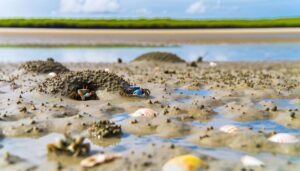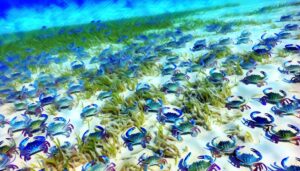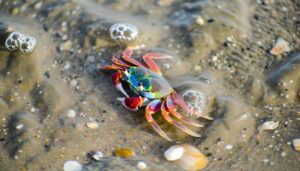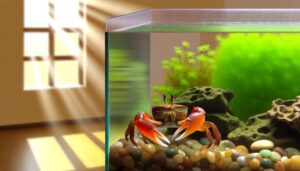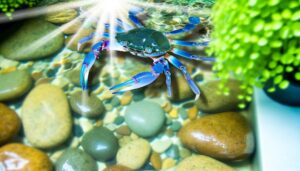How Do Fiddler Crabs Crawl in Grass?
Fiddler crabs exhibit partial eye closure during sleep, balancing vigilance and restorative rest. Their compound eyes, composed of numerous ommatidia, can retract on stalks, reducing visual input.
Eye closure minimizes sensory overload and conserves energy, aligning with circadian rhythms influenced by light exposure and tidal changes. Crabs in sheltered environments or low-light conditions show more consistent eye closure, highlighting the impact of environmental factors.
This partial eye closure allows them to maintain some level of responsiveness to predators, illustrating an adaptive evolutionary trait. For a deeper understanding of fiddler crab sleep behaviors, including comparisons with other crustaceans, further exploration is beneficial.
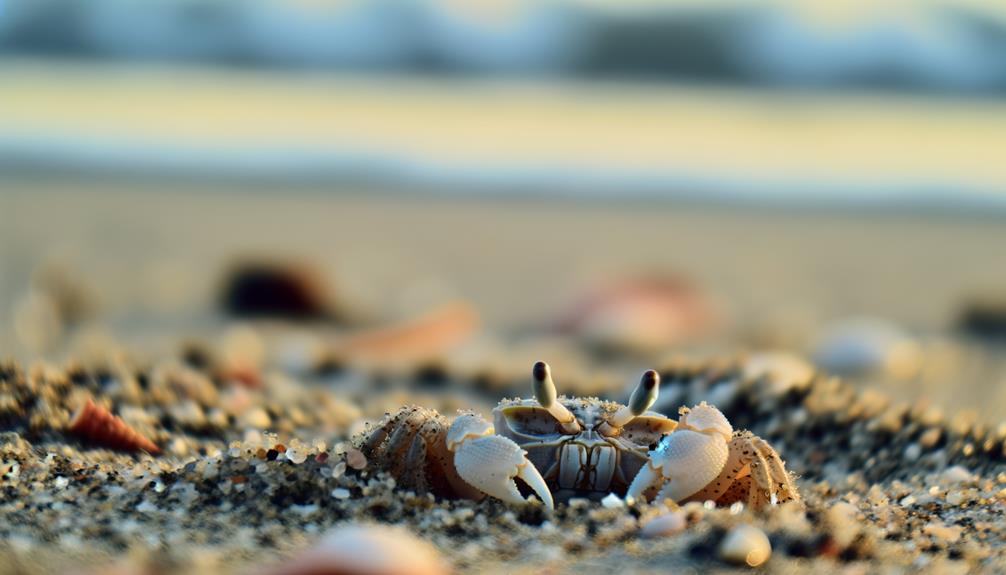
Key Takeaways
- Fiddler crabs exhibit partial eye closure during sleep.
- Eye closure in fiddler crabs is influenced by circadian rhythms and environmental stimuli.
- Reduced light levels often trigger eye closure in fiddler crabs.
- Eye closure helps conserve energy and reduce sensory overload during rest.
- Partial eye closure allows a balance between vigilance against predators and restorative sleep.
Fiddler Crab Anatomy
Fiddler crabs (genus Uca) exhibit a distinctive anatomical structure characterized by sexually dimorphic chelae, a robust carapace, and highly specialized compound eyes.
The males possess one enlarged chela, which serves both as a weapon in combat and an instrument of attraction during mating displays. The carapace, typically oval and flattened, provides essential protection against predators and environmental stressors. Additionally, their compound eyes are mounted on stalks, granting a wide field of vision important for detecting movement and potential threats in their habitat.
These eyes are composed of numerous ommatidia, each contributing to a mosaic-like image, optimizing visual acuity. Such anatomical adaptations are fundamental to the fiddler crab's survival and ecological niche within intertidal zones.
Sleep Patterns in Crustaceans
The sleep patterns in crustaceans, such as fiddler crabs, exhibit distinct rest cycles often influenced by their diurnal or nocturnal behaviors. These rest cycles are further modulated by environmental factors including tidal changes and light exposure.
Understanding these patterns provides insights into the adaptive strategies employed by crustaceans to optimize rest in varying ecological contexts.
Crustacean Rest Cycles
How do crustaceans, including fiddler crabs, exhibit sleep patterns that promote their physiological and behavioral well-being?
Crustaceans display distinct rest cycles characterized by periods of inactivity, which are vital for maintaining homeostasis.
Fiddler crabs, for instance, demonstrate a reduced metabolic rate and limited movement during these rest phases. This inactivity aids in conserving energy and supports cellular repair processes.
Observational studies have shown that crustaceans often seek sheltered environments during rest periods, minimizing predation risks.
Moreover, the synchronization of rest with tidal and light cycles suggests adaptive evolutionary mechanisms.
These rest periods are not just passive but essential for best physiological functioning, highlighting the importance of understanding crustacean sleep patterns in ecological and biological research.
Nocturnal Vs. Diurnal Behavior
Crustaceans, including fiddler crabs, exhibit distinct nocturnal and diurnal behaviors that are intricately linked to their sleep patterns and overall survival strategies. These behavioral patterns are essential for optimizing energy conservation, predator avoidance, and foraging efficiency.
Nocturnal Behavior: Many crustaceans are active during the night, reducing predation risks by utilizing darkness for camouflage.
Diurnal Behavior: Conversely, some species, like certain fiddler crabs, are more active during daylight, leveraging visual cues for social interactions and territory defense.
Circadian Rhythms: The activity cycles are regulated by endogenous circadian rhythms, which align physiological processes with environmental light-dark cycles.
Understanding these patterns is vital for comprehending the ecological niches and adaptive strategies of various crustacean species.
Environmental Sleep Influences
Environmental factors greatly shape the sleep patterns of crustaceans, influencing their physiological and behavioral adaptations to their habitats. Variations in light exposure, tidal cycles, and temperature fluctuations significantly impact their sleep-wake cycles. For instance, fiddler crabs demonstrate distinct sleep behaviors aligned with tidal rhythms, exhibiting increased activity during low tides and resting during high tides. Additionally, light intensity can modulate their sleep, where decreased illumination during nighttime leads to extended rest periods. Temperature changes also play a vital role, as cooler temperatures generally induce longer sleep durations.
| Environmental Factor | Impact on Sleep Pattern |
|---|---|
| Light Exposure | Modulates sleep duration |
| Tidal Cycles | Aligns activity and rest periods |
| Temperature | Influences sleep duration |
Understanding these influences provides insights into the adaptive strategies of crustaceans.
Understanding Fiddler Crab Vision
Fiddler crabs possess compound eyes, consisting of numerous ommatidia that facilitate a broad field of view and motion detection.
These specialized structures are adept at detecting variations in light intensity, which is essential for moving through their intertidal habitats.
The light detection mechanism in fiddler crabs involves photoreceptor cells that respond to specific wavelengths, enabling the crabs to discern changes in their environment effectively.
Compound Eye Structure
The compound eyes of fiddler crabs are highly specialized structures that provide a wide field of view and acute sensitivity to motion, necessary for moving around their intertidal habitats. These eyes are mounted on stalks, enabling panoramic vision and facilitating the detection of predators and prey. The compound eye is composed of numerous ommatidia, each functioning as an individual photoreceptive unit.
Key features include:
- Wide Field of View: Allows for constant environmental monitoring.
- Motion Detection: Essential for recognizing predators and prey movements.
- Stalked Eye Position: Enhances visual range and depth perception.
This sophisticated visual system is vital for the fiddler crab's survival, ensuring efficient navigation and interaction within their dynamic ecosystem.
Light Detection Mechanism
A critical aspect of the fiddler crab's vision lies in its ability to detect and analyze varying light intensities through specialized photoreceptors. These photoreceptors are embedded within the crab's compound eyes, each consisting of numerous ommatidia.
Each ommatidium houses a corneal lens, crystalline cone, and photoreceptor cells that facilitate the absorption of photons. This complex arrangement enables fiddler crabs to discern subtle changes in light, which is essential for their survival in intertidal environments.
Additionally, the visual system integrates signals from multiple ommatidia, enhancing contrast and motion detection. Such advanced light detection mechanisms allow fiddler crabs to effectively navigate their habitat, avoid predators, and engage in social interactions, thereby underpinning their behavioral ecology.
Eye Structure and Function
Crab vision is facilitated through a pair of compound eyes, each composed of numerous ommatidia that function collectively to provide a wide field of view and detect motion efficiently. These ommatidia are individual photoreceptive units, each containing a lens and photoreceptor cells, contributing to the crab's ability to perceive its surroundings in a mosaic-like image.
The unique eye structure endows fiddler crabs with several adaptive advantages:
- Wide Field of View: Enables the detection of predators and prey over a broad area.
- Motion Detection: The sensitivity to movement allows quick responses to environmental changes.
- Light Sensitivity: Adapted to varying light conditions, aiding in diurnal and nocturnal activities.
This complex visual system is essential for survival in their dynamic habitats.
Signs of Sleep in Fiddler Crabs
Observations of fiddler crabs indicate that they exhibit distinct behaviors consistent with sleep, including periods of immobility and eye closure. During these phases, fiddler crabs often withdraw to their burrows, reducing their metabolic rate and displaying minimal movement.
This immobility is typically accompanied by a retraction of their eyestalks into a more relaxed position. Additionally, electrophysiological studies reveal a decrease in neural activity, correlating with a rest state. These behaviors suggest a cyclic pattern of rest and activity, indicative of sleep.
Furthermore, the duration and timing of these periods are influenced by tidal and diurnal cycles, aligning with environmental cues. These observations underscore the importance of sleep-like states in maintaining physiological homeostasis in fiddler crabs.
Do Fiddler Crabs Close Their Eyes?
Despite their simple anatomy, fiddler crabs exhibit a distinct behavior of periodically closing their eyes, particularly when engaging in sleep-like states. Detailed observations have noted that this eye closure is not continuous but occurs intermittently.
Several factors contribute to this behavior:
- Circadian Rhythms: Fiddler crabs demonstrate a daily cycle of activity and rest, during which eye closure is more frequent.
- Environmental Stimuli: Reduction of visual input from potential threats or disturbances can trigger eye closure.
- Physiological Needs: Inactivity and low metabolic rates during rest periods may necessitate eye closure.
This intermittent eye-closing behavior is indicative of their adaptation to conserve energy and reduce sensory overload, aligning with their overall survival mechanisms in a dynamic habitat.
Comparing With Other Crustaceans
In comparison to fiddler crabs, other crustaceans such as lobsters and shrimp exhibit varying eye closure behaviors influenced by different environmental and physiological factors.
Lobsters, for example, possess compound eyes that do not close but may exhibit reduced activity during rest periods. Shrimp, similarly, have fixed eyes that lack eyelids, thus remaining open continuously.
These differences suggest that eye closure mechanisms among crustaceans are diverse and adapted to their respective habitats and lifestyles.
Fiddler crabs, which can retract their eyestalks as a protective behavior, differ notably in their sleep-related eye mechanisms.
Such variations indicate a complex interplay between evolutionary adaptations and ecological demands across crustacean species, highlighting the unique physiological traits each species has developed for survival.
Environmental Factors
Environmental factors can significantly impact the eye closure behavior of fiddler crabs during sleep. These factors include light levels, habitat type, and predation risk. Light intensity plays a crucial role, with fiddler crabs more likely to close their eyes in low-light conditions. Crabs in burrows or shaded areas tend to exhibit more consistent eye closure behavior compared to those in open, exposed environments. The perceived threat of predators can also influence eye closure, as crabs may remain vigilant with their eyes open to detect danger.
These varied environmental conditions highlight the complexity of sleep-related behaviors in fiddler crabs.
Research Findings
Recent studies have provided detailed insights into the mechanisms and patterns of eye closure in fiddler crabs during sleep. Researchers observed that fiddler crabs exhibit a unique form of partial eye closure, where the eyestalks retract slightly but do not completely close. This partial retraction is hypothesized to serve as a balance between maintaining vigilance against predators and achieving restorative sleep.
Electrophysiological recordings revealed distinct sleep stages characterized by reduced sensory processing and motor activity. Behavioral experiments confirmed that fiddler crabs in this state exhibit lower responsiveness to external stimuli. These findings suggest that the partial eye closure mechanism in fiddler crabs is an adaptive trait, optimized for survival in their natural habitats while still allowing for necessary rest periods.
Conclusion
The examination of fiddler crab sleep behaviors reveals a fascinating coincidence between their anatomical features and sleep patterns.
Despite possessing prominent compound eyes, fiddler crabs do not close their eyes while sleeping, a trait shared with several other crustaceans.
The interplay between environmental factors and the unique structure of their visual system underscores the complexity of their sleep mechanisms.
Research findings highlight the need for further studies to fully understand these intricate biological processes.

